

March 29 2021

Slitter rewinders have one goal: to achieve high-quality finished rolls as quickly and as safely as possible. No matter what the material is, every facility wants to achieve the optimum output level without sacrificing the finished product quality. An adequate roll handling system is needed to achieve the desired level of productivity and quality.
Depending on the material being converted and the type of operation, the slitter's roll handling side may look different. A converter producing inconsistent roll sizes may opt for a strictly manual system. In comparison, a production facility with a consistent product may prefer a more automatic system. However, depending on the production level, when a facility uses a cantilevered style slitter, which is a more standard style due to the ease of roll handling, there are still considerations regarding how the finished rolls are removed.
Usually, unloading finished rewind packages from a cantilevered slitter falls within three levels of roll handling.
Manual System – not all roll handling systems need a fully or even semi-automatic system. When each finished roll reaches a maximum weight, a capacity designated by the facility management, the roll is manually pushed off onto an unloader. This type of handling is a more cost-effective solution, but there are obvious limitations to the roll's size depending on the material type. At a given diameter, materials with lower bulk densities, such as foam and nonwovens, will have a lower finished roll weight than higher density materials (like paper, plastics, and foils) at this same diameter. Meeting ergonomic guidelines will often require higher density materials to be wound at smaller diameters than other lower density materials. Standard manual unload stands, like the Dusenbery US1 and US2, have cantilevered bars that align with the rewind shafts to allow the operator to slide the finished set onto the stand without lifting. These stands then pivot away from the machine to allow removal by portable roll handlers.
Semi-automatic – many budget-minded systems employ a system that uses a roll pusher to expel the finished rolls from the cantilevered mandrels but use unload stands that are still manually operated. These unload stands are typically used for heavier roll weights and can include added functionality like a rotation system that mechanically pivots the finished set to the horizontal plane for ease unloading, like the Dusenbery US3 unloader.
Fully-automated – when production capacity is at its max, a fully-automatic system is the way to go. When the finished rolls reach maximum diameter, the roll pusher expels the rolls onto an unload stand with motorized pivoting. Like the Dusenbery US3, the US4 provides added safety since the operator no longer needs to manually transfer the rolls or manipulate the unload tree itself, speeding up the unloading process. Automated handling equipment can then interface with these stands to remove the finished rolls and load a new set of cores, providing a highly productive system.
Finished roll handling comes down to the capacity of the slitter and the ergonomic requirements identified by facility management. If the slitter capacity is light, with lighter finished rolls, then a manual system is adequate. However, if the slitter capacity is high, with faster roll transfer and heavier rolls, then a fully automatic system is recommended. This type of system also provides a higher level of safety since the operator can observe the transfer operation from a safe distance away.
For more information about the roll handling equipment, like roll-pushers and unload stands from Dusenbery Converting Systems, please contact us at sales@parkinsontechnologies.com or fill out the form below.